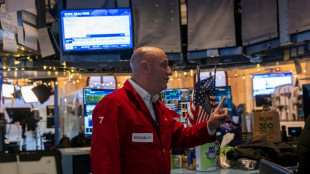
-
 North Korean POWs in Ukraine seeking 'new life' in South
North Korean POWs in Ukraine seeking 'new life' in South
-
Japanese golf star 'Jumbo' Ozaki dies aged 78

-
 Johnson, Castle shine as Spurs rout Thunder
Johnson, Castle shine as Spurs rout Thunder
-
Thai border clashes hit tourism at Cambodia's Angkor temples

-
 From predator to plate: Japan bear crisis sparks culinary craze
From predator to plate: Japan bear crisis sparks culinary craze
-
Asian markets mostly up after US growth fuels Wall St record

-
 'Happy milestone': Pakistan's historic brewery cheers export licence
'Happy milestone': Pakistan's historic brewery cheers export licence
-
Chevron: the only foreign oil company left in Venezuela

-
 US denies visas to EU ex-commissioner, four others over tech rules
US denies visas to EU ex-commissioner, four others over tech rules
-
Koepka leaves LIV Golf: official

-
 US slams China policies on chips but will delay tariffs to 2027
US slams China policies on chips but will delay tariffs to 2027
-
Arsenal reach League Cup semis with shoot-out win over Palace

-
 Contenders Senegal, Nigeria start Cup of Nations campaigns with wins
Contenders Senegal, Nigeria start Cup of Nations campaigns with wins
-
Tunisia ease past Uganda to win Cup of Nations opener

-
 S&P 500 surges to record after strong US economic report
S&P 500 surges to record after strong US economic report
-
UK police say no action against Bob Vylan duo over Israel army chant

-
 Libya's top military chief killed in plane crash in Turkey
Libya's top military chief killed in plane crash in Turkey
-
Venezuela passes law to jail backers of US oil blockade

-
 French parliament passes emergency budget extension
French parliament passes emergency budget extension
-
Trump in Epstein files: five takeaways from latest release

-
 Wasteful Nigeria open AFCON campaign with narrow win over Tanzania
Wasteful Nigeria open AFCON campaign with narrow win over Tanzania
-
Ukraine retreats in east as Russian strikes kill three, hit energy

-
 Macron meets French farmers in bid to defuse anger over trade deal
Macron meets French farmers in bid to defuse anger over trade deal
-
Ineos snap up Scotsman Onley

-
 World is 'ready' for a woman at helm of UN: Chile's Bachelet tells AFP
World is 'ready' for a woman at helm of UN: Chile's Bachelet tells AFP
-
Real Madrid's Endrick joins Lyon on loan

-
 Latest Epstein files renew scrutiny of Britain's ex-prince Andrew
Latest Epstein files renew scrutiny of Britain's ex-prince Andrew
-
US consumer confidence tumbles in December

-
 Norwegian biathlete Sivert Guttorm Bakken found dead in hotel
Norwegian biathlete Sivert Guttorm Bakken found dead in hotel
-
UK comedian Russell Brand faces two new rape, assault charges: police

-
 Venezuela seeks to jail backers of US oil blockade
Venezuela seeks to jail backers of US oil blockade
-
Norwegian biathlete Sivert Guttorm Bakken found dead

-
 Wall Street stocks edge higher
Wall Street stocks edge higher
-
Vietnam Communist Party endorses To Lam to stay in top job

-
 US economic growth surges in 3rd quarter, highest rate in two years
US economic growth surges in 3rd quarter, highest rate in two years
-
Frank defends Van de Ven after Slot slams 'reckless' foul on Isak

-
 Russian paramilitaries in CAR say take election threat 'extremely seriously'
Russian paramilitaries in CAR say take election threat 'extremely seriously'
-
Trump in the Epstein files: five takeaways from latest release

-
 UK govt to relax farmers inheritance tax after protests
UK govt to relax farmers inheritance tax after protests
-
Pakistani firm wins auction for state airline PIA

-
 Stocks slip on strong US growth data
Stocks slip on strong US growth data
-
DR Congo beat Benin to kick off Cup of Nations bid

-
 New Epstein files dump contains multiple Trump references
New Epstein files dump contains multiple Trump references
-
Russian strike could collapse Chernobyl shelter: plant director

-
 Springbok captain Kolisi to rejoin Stormers
Springbok captain Kolisi to rejoin Stormers
-
Italy fines Ryanair $300 mn for abuse of dominant position

-
 Mahrez eyes strong AFCON showing from Algeria
Mahrez eyes strong AFCON showing from Algeria
-
Killer in Croatia school attack gets maximum 50-year sentence

-
 Thousands of new Epstein-linked documents released by US Justice Dept
Thousands of new Epstein-linked documents released by US Justice Dept
-
Stocks steady as rate cut hopes bring Christmas cheer


The winding, fitful path to weight loss drug Ozempic
Half a century of advancements in biomedical science paved the way for today's powerful weight-loss drugs like Ozempic -- so what was that journey like for the scientists involved?
Joel Habener of Massachusetts General Hospital and Svetlana Mojsov of The Rockefeller University, who are being honored with the prestigious Lasker Award for their role in the research, spoke to AFP about how they made the discoveries that changed the way we think about weight.
The pair will share the award -- often considered a predictor of future Nobel success -- as well as an honorarium of $250,000 with Lotte Bjerre Knudsen of Novo Nordisk, which manufactures Ozempic.
- Early molecular biology -
Obesity has escalated into a global health crisis, affecting 900 million people worldwide -- including over 40 percent of Americans and nearly a quarter of Europeans.
But back in the mid-1970s, when Habener, now 87, began his career as a physician-scientist, his curiosity was focused on diabetes.
He was particularly interested in the pancreatic hormone glucagon, known for raising blood sugar levels -- the opposite effect of insulin, which was already used as a treatment for diabetes.
By understanding and potentially modulating glucagon's effects, Habener believed he could uncover new ways to manage diabetes.
To pursue this, he turned to the emerging field of molecular biology, aiming to isolate and clone the gene that encodes glucagon.
- Fortuitous turn to fish -
But he quickly hit a roadblock: the US National Institutes of Health had just banned the type of research he planned to conduct on mammalian genes.
This pushed him to pivot to studying the anglerfish, a creature with a unique endocrine organ outside the pancreas.
"It turned out to be a godsend in terms of simplicity," he recalled, describing the eureka moment when he isolated a precursor protein that gave rise to glucagon -- as well as a second hormone that resembled glucagon.
Though Habener didn't realize its significance at the time, this turned out to be the fish-equivalent of "GLP-1," the foundation for today's diabetes and obesity drugs.
"That's what's beautiful about discovery research," he said. "By exploring the unknown, you get surprises."
- Identifying GLP-1's potential -
Mojsov, who emigrated from Yugoslavia, took the early discoveries made by Habener and others further with several important contributions.
Poring over the hormone's structure, she correctly predicted the active form of GLP-1 and devised innovative chemistry methods to synthesize it.
She also proposed that GLP-1 would be released in the intestines and act to trigger insulin production. Together with Habener and others, she proved this theory through lab experiments and human trials, identifying its therapeutic potential.
"I was sure it would be a good drug for diabetes," said the 76-year-old. However, at the time, there was no scientific evidence that hormones could regulate weight.
It was only later studies by Habener, Mojsov, and others that revealed GLP-1's ability to slow stomach emptying and its interaction with receptors in the brain, helping to curb appetite and possibly even address substance addictions.
- New era of treatments -
Starting in the 1990s, Knudsen, the head of GLP-1 therapeutics at Novo Nordisk, and her team built on these breakthroughs to develop treatments for diabetes (Ozempic) and obesity (Wegovy), extending the drug's therapeutic effects from just a few hours to over a week.
"Now we can see that GLP-1 actually has a much broader spectrum of health benefits," said Mojsov, though she laughs off the "miracle drug" label.
Obese patients "lose a lot of weight but also their muscle mass, and that's also very serious," she stressed. "I think it should never be taken for cosmetic reasons."
GLP-1 drugs have now been approved for treating cardiovascular disease, and emerging evidence suggests they may offer protective effects against dementia.
Though the exact mechanism remains unclear, Habener suggests their ability to suppress inflammatory pathways might be the common link.
As for the future, Mojsov is optimistic. She foresees a new generation of similar drugs that will further minimize side effects and target an even broader range of diseases.
T.Ward--AMWN



